Chairman of the State Administration Council Prime Minister Senior General Min Aung Hlaing, accompanied by Council Joint Secretary General Ye Win Oo, the Yangon Region Chief Minister, the Commander of Yangon Command and officials, inspected the production of the Solar Panel Factory, Tyre Factory (Ywama), No 3 Steel Mill (Ywama) and No 2 Steel Mill (Myaungtaga) in Yangon Region yesterday morning.
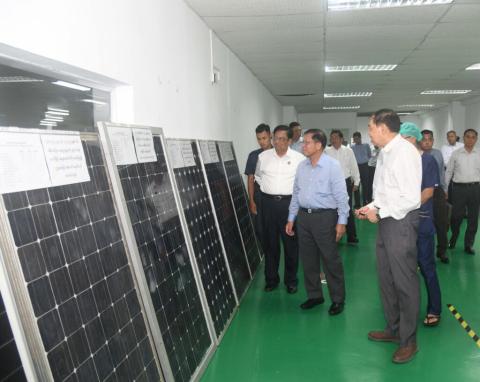
Chairman of the State Administration Council Prime Minister Senior General Min Aung Hlaing, accompanied by Council Joint Secretary General Ye Win Oo, the Yangon Region Chief Minister, the Commander of Yangon Command and officials, inspected the production of the Solar Panel Factory, Tyre Factory (Ywama), No 3 Steel Mill (Ywama) and No 2 Steel Mill (Myaungtaga) in Yangon Region yesterday morning.
Read more: https://www.gnlm.com.mm/renewable-energy-drive-powers-solar-factories/
Chairman of the State Administration Council Prime Minister Senior General Min Aung Hlaing, accompanied by Council Joint Secretary General Ye Win Oo, the Yangon Region Chief Minister, the Commander of Yangon Command and officials, inspected the production of the Solar Panel Factory, Tyre Factory (Ywama), No 3 Steel Mill (Ywama) and No 2 Steel Mill (Myaungtaga) in Yangon Region yesterday morning.
Read more: https://www.gnlm.com.mm/renewable-energy-drive-powers-solar-factories/
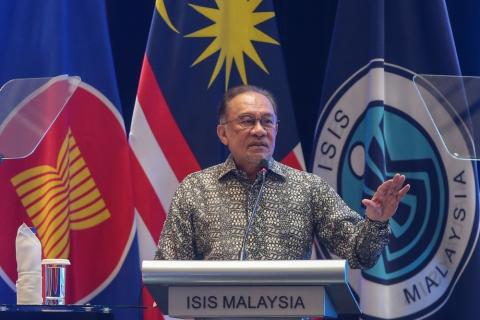
KUALA LUMPUR, June 19 — Prime Minister Datuk Seri Anwar Ibrahim today said that Putrajaya’s ongoing negotiations with Washington over unilateral tariffs imposed by former US President Donald Trump are “going excellent”.
KUALA LUMPUR, June 19 — Prime Minister Datuk Seri Anwar Ibrahim today said that Putrajaya’s ongoing negotiations with Washington over unilateral tariffs imposed by former US President Donald Trump are “going excellent”.
He said two ministers — Investment, Trade and Industry Minister Datuk Seri Tengku Zafrul Abdul Aziz and Finance Minister II Datuk Seri Amir Hamzah Azizan — held talks with US Secretary of Commerce Howard Lutnick yesterday to advance the tariff negotiations. “I said to them to secure what is fair for Malaysia but also present the case that is best for Asean too,” he said, during his keynote address at the 38th Asia-Pacific Roundtable (APR) at Hilton KL, here, today.
Malaysia currently faces a 24 per cent tariff on all goods entering the US, and is seeking to lower the rate to the 10 per cent baseline tariff. Anwar acknowledged the economic strain caused by the tariffs but stressed that Malaysia’s bilateral relations with the US remain strong.
“Some of our differences in foreign policies cannot be too exaggerated because our bilateral relations with the US remains strong,” he said.
Anwar added that Asean is working to upgrade trade agreements with member states and dialogue partners, as the US tariffs continue to cast a shadow over the region.
He also said he was confident that the conclusion of the Digital Economic Framework Agreement (Defa) will help unlock the potential of the region’s digital economy.
The agreement is to be the world’s first region-wide and legally binding agreement on digital economy governance.
“In the face of rising protectionism, we must remind ourselves that trade is not a sideshow to security — it is part of the scaffolding that holds the region together,” he said.
“When trade falters, fractures follow.”
Anwar also defended Asean leaders’ engagement with the BRICS bloc, saying it should not be seen as an anti-Western move but rather a means to tackle shared challenges.
BRICS comprises Brazil, Russia, India, China and South Africa.
“The recent reinvigoration of BRICS to include members and partner countries from the Middle East, Southeast Asia, Central Asia, Africa, and South America, is the very essence of bridging regions,” he said.
“It is an opportunity to build new partnerships and renew old ones,” he added.
Malaysia formally applied to join BRICS in July 2024 and was admitted as a partner country in October.
Indonesia and Thailand are also partner countries in the alliance.
ကိုးကား- Malay Mail
KUALA LUMPUR, June 19 — Prime Minister Datuk Seri Anwar Ibrahim today said that Putrajaya’s ongoing negotiations with Washington over unilateral tariffs imposed by former US President Donald Trump are “going excellent”.
He said two ministers — Investment, Trade and Industry Minister Datuk Seri Tengku Zafrul Abdul Aziz and Finance Minister II Datuk Seri Amir Hamzah Azizan — held talks with US Secretary of Commerce Howard Lutnick yesterday to advance the tariff negotiations. “I said to them to secure what is fair for Malaysia but also present the case that is best for Asean too,” he said, during his keynote address at the 38th Asia-Pacific Roundtable (APR) at Hilton KL, here, today.
Malaysia currently faces a 24 per cent tariff on all goods entering the US, and is seeking to lower the rate to the 10 per cent baseline tariff. Anwar acknowledged the economic strain caused by the tariffs but stressed that Malaysia’s bilateral relations with the US remain strong.
“Some of our differences in foreign policies cannot be too exaggerated because our bilateral relations with the US remains strong,” he said.
Anwar added that Asean is working to upgrade trade agreements with member states and dialogue partners, as the US tariffs continue to cast a shadow over the region.
He also said he was confident that the conclusion of the Digital Economic Framework Agreement (Defa) will help unlock the potential of the region’s digital economy.
The agreement is to be the world’s first region-wide and legally binding agreement on digital economy governance.
“In the face of rising protectionism, we must remind ourselves that trade is not a sideshow to security — it is part of the scaffolding that holds the region together,” he said.
“When trade falters, fractures follow.”
Anwar also defended Asean leaders’ engagement with the BRICS bloc, saying it should not be seen as an anti-Western move but rather a means to tackle shared challenges.
BRICS comprises Brazil, Russia, India, China and South Africa.
“The recent reinvigoration of BRICS to include members and partner countries from the Middle East, Southeast Asia, Central Asia, Africa, and South America, is the very essence of bridging regions,” he said.
“It is an opportunity to build new partnerships and renew old ones,” he added.
Malaysia formally applied to join BRICS in July 2024 and was admitted as a partner country in October.
Indonesia and Thailand are also partner countries in the alliance.
ကိုးကား- Malay Mail
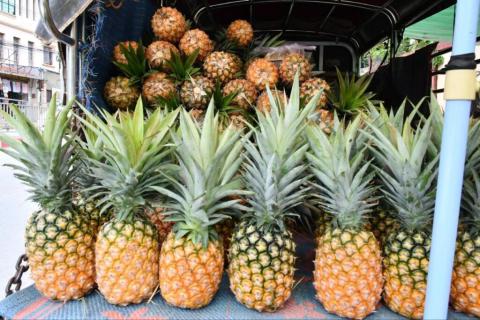
The purchase of pineapples has increased during their season, according to sellers and consumers. Due to the plenty of supply, the price is cheap, and pineapple is a favourable fruit for consumers, said a seller.
“Pineapple is abundantly available in the monsoon, and both old people and young people enjoy it. People eat it as a snack and also cook it. It is the season when the supply is abundant and the price is also cheap,” said a seller.
Some buy them to resell as juice.
The purchase of pineapples has increased during their season, according to sellers and consumers. Due to the plenty of supply, the price is cheap, and pineapple is a favourable fruit for consumers, said a seller.
“Pineapple is abundantly available in the monsoon, and both old people and young people enjoy it. People eat it as a snack and also cook it. It is the season when the supply is abundant and the price is also cheap,” said a seller.
Some buy them to resell as juice.
“Pineapple is rich in Vitamin C and other health benefits. So, we eat it often,” said a woman. — MT/ZS
Source: The Global New Light of Myanmar
The purchase of pineapples has increased during their season, according to sellers and consumers. Due to the plenty of supply, the price is cheap, and pineapple is a favourable fruit for consumers, said a seller.
“Pineapple is abundantly available in the monsoon, and both old people and young people enjoy it. People eat it as a snack and also cook it. It is the season when the supply is abundant and the price is also cheap,” said a seller.
Some buy them to resell as juice.
“Pineapple is rich in Vitamin C and other health benefits. So, we eat it often,” said a woman. — MT/ZS
Source: The Global New Light of Myanmar
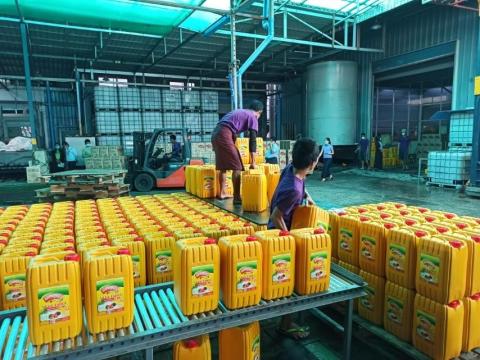
Palm oil reference price was set for a six-month low at K6,110 per viss in a week ending 22 June as weak global palm oil prices are closely tied to domestic palm oil reference prices, according to the Supervisory Committee on Edible Oil Import and Distribution under the Ministry of Commerce.
Myanmar imports edible oil to meet the domestic growing demand. The imported CIF price (Cost, Insurance and Freight) for palm oil has been declining since January 2025. The wholesale reference price declined to K6,110 per viss in the week ending 22 June from K7,280 in the first week of January.
Palm oil reference price was set for a six-month low at K6,110 per viss in a week ending 22 June as weak global palm oil prices are closely tied to domestic palm oil reference prices, according to the Supervisory Committee on Edible Oil Import and Distribution under the Ministry of Commerce.
Myanmar imports edible oil to meet the domestic growing demand. The imported CIF price (Cost, Insurance and Freight) for palm oil has been declining since January 2025. The wholesale reference price declined to K6,110 per viss in the week ending 22 June from K7,280 in the first week of January.
The Supervisory Committee on Edible Oil Import and Distribution under the Ministry of Commerce has been closely observing the FOB prices in Malaysia and Indonesia, adding transport costs, tariffs and banking services to decide the wholesale market reference rate for edible oil weekly.
The committee issues reference prices weekly every Monday through the website www.doca.gov.mm of the Department of Consumer Affairs and the Facebook pages of the department and the Myanmar Edible Oil Dealers’ Association. Despite the reference price, the market price is way too high.
To control overcharging, the Consumer Affairs Department under the Ministry of Commerce informed consumers of lodging complaints for overcharging through the call centre hotline.
The department urges consumers not to buy palm oil at high prices.
The Committee notified that any person who is involved in price gouging and oil storage to attempt market manipulation will face legal action under the Essential Goods and Services Law.
The department is working together with the Myanmar Oil Dealers’ Association and the cooking oil importing companies to offer affordable rates of imported palm oil for consumers.
The complaints for overcharging can be lodged over hotline 1535 of the call centre of the Consumers Affairs Department or sent to the Facebook page of the department and the region and state departments concerned.
The domestic consumption of palm oil is estimated at one million tonnes per year. The local palm oil production is just about 400,000 tonnes. About 700,000 tonnes of palm oil are yearly imported through Malaysia and Indonesia to meet domestic demand. — NN/KK
GNLM
Palm oil reference price was set for a six-month low at K6,110 per viss in a week ending 22 June as weak global palm oil prices are closely tied to domestic palm oil reference prices, according to the Supervisory Committee on Edible Oil Import and Distribution under the Ministry of Commerce.
Myanmar imports edible oil to meet the domestic growing demand. The imported CIF price (Cost, Insurance and Freight) for palm oil has been declining since January 2025. The wholesale reference price declined to K6,110 per viss in the week ending 22 June from K7,280 in the first week of January.
The Supervisory Committee on Edible Oil Import and Distribution under the Ministry of Commerce has been closely observing the FOB prices in Malaysia and Indonesia, adding transport costs, tariffs and banking services to decide the wholesale market reference rate for edible oil weekly.
The committee issues reference prices weekly every Monday through the website www.doca.gov.mm of the Department of Consumer Affairs and the Facebook pages of the department and the Myanmar Edible Oil Dealers’ Association. Despite the reference price, the market price is way too high.
To control overcharging, the Consumer Affairs Department under the Ministry of Commerce informed consumers of lodging complaints for overcharging through the call centre hotline.
The department urges consumers not to buy palm oil at high prices.
The Committee notified that any person who is involved in price gouging and oil storage to attempt market manipulation will face legal action under the Essential Goods and Services Law.
The department is working together with the Myanmar Oil Dealers’ Association and the cooking oil importing companies to offer affordable rates of imported palm oil for consumers.
The complaints for overcharging can be lodged over hotline 1535 of the call centre of the Consumers Affairs Department or sent to the Facebook page of the department and the region and state departments concerned.
The domestic consumption of palm oil is estimated at one million tonnes per year. The local palm oil production is just about 400,000 tonnes. About 700,000 tonnes of palm oil are yearly imported through Malaysia and Indonesia to meet domestic demand. — NN/KK
GNLM
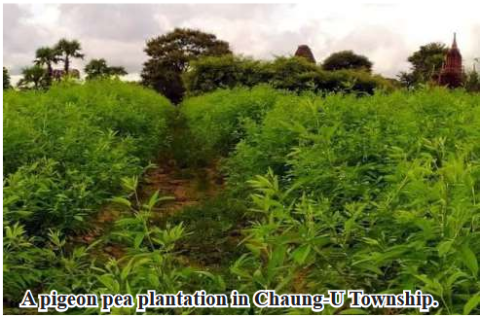
Chaung-U June 19
In Chaung-U Township, part of Monywa District in the Sagaing Region, more than 2,000 acres of pigeon pea have already been cultivated during this year's monsoon crop season, according to data from the ChaungU Township Agriculture Department.
For the 2025-2026 monsoon season, Chaung-U Township had planned to cultivate 20,300 acres of pigeon pea. Planting began in May this year, and as of today, 2,673 acres have been successfully cultivated.
Chaung-U June 19
In Chaung-U Township, part of Monywa District in the Sagaing Region, more than 2,000 acres of pigeon pea have already been cultivated during this year's monsoon crop season, according to data from the ChaungU Township Agriculture Department.
For the 2025-2026 monsoon season, Chaung-U Township had planned to cultivate 20,300 acres of pigeon pea. Planting began in May this year, and as of today, 2,673 acres have been successfully cultivated.
"This monsoon season, Chaung-U Township aimed to grow pigeon pea on over 20,000 acres. To date, more than 2,000 acres have already been planted," said U Tint Swe, the head of the ChaungU Township Agriculture Department. "We are working to ensure the cultivation meets the targeted acreage while also focusing on improving yield. Farmers grow pigeon pea both as a standalone crop and as an intercrop."
This year, the township agriculture department has been providing on-field training to pigeon pea farmers on selecting high-quality seeds, proper cultivation techniques, pest control, and yield improvement.
Additionally, to reduce costs for farmers, the department is promoting a fertilizer blending technique using urea and potash. This method not only lowers cultivation expenses but also helps keep crops pestfree and enhances plant growth.
Source: Yadanar Bon Newspaper
Chaung-U June 19
In Chaung-U Township, part of Monywa District in the Sagaing Region, more than 2,000 acres of pigeon pea have already been cultivated during this year's monsoon crop season, according to data from the ChaungU Township Agriculture Department.
For the 2025-2026 monsoon season, Chaung-U Township had planned to cultivate 20,300 acres of pigeon pea. Planting began in May this year, and as of today, 2,673 acres have been successfully cultivated.
"This monsoon season, Chaung-U Township aimed to grow pigeon pea on over 20,000 acres. To date, more than 2,000 acres have already been planted," said U Tint Swe, the head of the ChaungU Township Agriculture Department. "We are working to ensure the cultivation meets the targeted acreage while also focusing on improving yield. Farmers grow pigeon pea both as a standalone crop and as an intercrop."
This year, the township agriculture department has been providing on-field training to pigeon pea farmers on selecting high-quality seeds, proper cultivation techniques, pest control, and yield improvement.
Additionally, to reduce costs for farmers, the department is promoting a fertilizer blending technique using urea and potash. This method not only lowers cultivation expenses but also helps keep crops pestfree and enhances plant growth.
Source: Yadanar Bon Newspaper
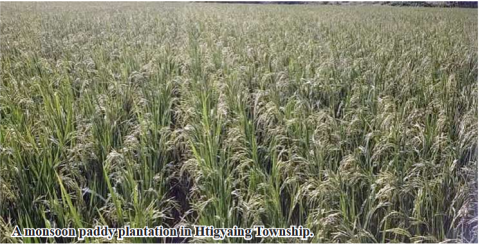
Htigyaing June 19
More than 40,000 acres of rain-fed rice will be planted in Htigyaing Township, Katha District, Sagaing Region during this year rain crops planting season, according to the Department of Agriculture for Htigyaing Township.
During the 2025-2026 rain crops planting season, Htigyaing Township is planning to plant 40,278 acres of rain-fed rice, and the rainfed rice cultivation will begin from July to September this year.
Htigyaing June 19
More than 40,000 acres of rain-fed rice will be planted in Htigyaing Township, Katha District, Sagaing Region during this year rain crops planting season, according to the Department of Agriculture for Htigyaing Township.
During the 2025-2026 rain crops planting season, Htigyaing Township is planning to plant 40,278 acres of rain-fed rice, and the rainfed rice cultivation will begin from July to September this year.
“This year, Htigyaing Township is planning to plant more than 40,000 acres of rain-fed rice. We will work to ensure that the targeted acres are planted. We will provide the necessary technology and varieties for rain-fed rice cultivation. We will conduct field visits to help farmers to plant rainfed rice on time,” said U Ko Ko Aung, head of the Department of Agriculture for Htigyaing Township.
This year, the relevant Township Department of Agriculture and local farmers will work together to ensure that rain-fed rice cultivation is carried out without any difficulties during the rain crops planting season.
Source: Yadanar Bon Newspaper
Htigyaing June 19
More than 40,000 acres of rain-fed rice will be planted in Htigyaing Township, Katha District, Sagaing Region during this year rain crops planting season, according to the Department of Agriculture for Htigyaing Township.
During the 2025-2026 rain crops planting season, Htigyaing Township is planning to plant 40,278 acres of rain-fed rice, and the rainfed rice cultivation will begin from July to September this year.
“This year, Htigyaing Township is planning to plant more than 40,000 acres of rain-fed rice. We will work to ensure that the targeted acres are planted. We will provide the necessary technology and varieties for rain-fed rice cultivation. We will conduct field visits to help farmers to plant rainfed rice on time,” said U Ko Ko Aung, head of the Department of Agriculture for Htigyaing Township.
This year, the relevant Township Department of Agriculture and local farmers will work together to ensure that rain-fed rice cultivation is carried out without any difficulties during the rain crops planting season.
Source: Yadanar Bon Newspaper
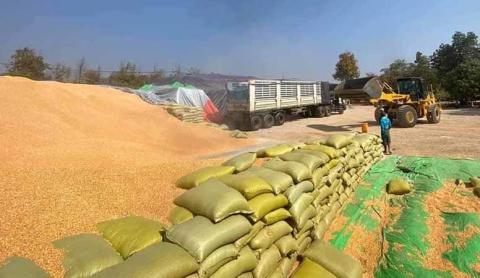
The maize price in the domestic market went up following strong global market sentiments and stock shortage in the domestic market.
Myanmar’s maize is primarily sent to Thailand at present with free customs duty. They are also sent to China, India, the Philippines and Bangladesh.
The maize price in the domestic market went up following strong global market sentiments and stock shortage in the domestic market.
Myanmar’s maize is primarily sent to Thailand at present with free customs duty. They are also sent to China, India, the Philippines and Bangladesh.
Thailand gives the green light for maize imports under zero tariff (with Form D), between 1 February and 31 August. However, Thailand imposes a maximum tax rate of 73 per cent on maize imports to protect the rights of their growers if the maize is imported during the maize season of Thailand.
Additionally, China has been purchasing Myanmar’s maize through cross-border trade under the alternative development programme. Legitimate maize trade between Myanmar and China commenced at the end of 2022. A total of 112 Myanmar companies have been permitted for maize exports.
The maize is cultivated in Shan, Kachin, Kayah and Kayin states and Mandalay, Sagaing and Magway regions. Myanmar has three maize seasons: winter, summer and monsoon. Myanmar’s annual maize output is estimated at 2.5-3 million tonnes. — NN/KK
Source: The Global New Light of Myanmar
The maize price in the domestic market went up following strong global market sentiments and stock shortage in the domestic market.
Myanmar’s maize is primarily sent to Thailand at present with free customs duty. They are also sent to China, India, the Philippines and Bangladesh.
Thailand gives the green light for maize imports under zero tariff (with Form D), between 1 February and 31 August. However, Thailand imposes a maximum tax rate of 73 per cent on maize imports to protect the rights of their growers if the maize is imported during the maize season of Thailand.
Additionally, China has been purchasing Myanmar’s maize through cross-border trade under the alternative development programme. Legitimate maize trade between Myanmar and China commenced at the end of 2022. A total of 112 Myanmar companies have been permitted for maize exports.
The maize is cultivated in Shan, Kachin, Kayah and Kayin states and Mandalay, Sagaing and Magway regions. Myanmar has three maize seasons: winter, summer and monsoon. Myanmar’s annual maize output is estimated at 2.5-3 million tonnes. — NN/KK
Source: The Global New Light of Myanmar

INSIDE a workshop at Chinese tech giant Xiaomi’s electric vehicle (EV) factory, the scene is a stark contrast to what one might expect to see on a factory floor.
With few workers in sight, robotic arms move with precision and speed, seamlessly assembling vehicle body components. Autonomous Mobile Robots (AMRs) glide across the floor, efficiently transporting materials to their designated stations.
INSIDE a workshop at Chinese tech giant Xiaomi’s electric vehicle (EV) factory, the scene is a stark contrast to what one might expect to see on a factory floor.
With few workers in sight, robotic arms move with precision and speed, seamlessly assembling vehicle body components. Autonomous Mobile Robots (AMRs) glide across the floor, efficiently transporting materials to their designated stations.
Xiaomi entered the EV market in 2021, setting up a state-of the-art factory spanning some 720,000 square metres in the Beijing Economic-Technological Development Area, also known as Beijing E-Town — a key innovation hub for China’s autonomous driving industry. The market newcomer unveiled its SU7 model in March 2024.
Every 76 seconds, a new Xiaomi vehicle rolls off the production line at the factory, with over 700 robots operating around the clock to enable the full automation of key processes such as large-scale die casting.
The factory embodies Xiaomi’s vision for smart manufacturing, in which intelligent machines take the lead and automation fuels both quality and efficiency. To Lei Jun, founder and chairman of Xiaomi, the importance of sustained investment in innovation is self-evident.
“Upholding our unwavering principle of ‘technology as the foundation,’ Xiaomi has invested over 100 billion yuan (about US$13.93 billion) in R&D over the past five years, making significant strides in many core capabilities.
In the next five years, we plan to invest another 200 billion yuan to pursue new heights in global next-generation hard tech,” Lei said. — Xinhua
Source: The Global New Light of Myanmar
INSIDE a workshop at Chinese tech giant Xiaomi’s electric vehicle (EV) factory, the scene is a stark contrast to what one might expect to see on a factory floor.
With few workers in sight, robotic arms move with precision and speed, seamlessly assembling vehicle body components. Autonomous Mobile Robots (AMRs) glide across the floor, efficiently transporting materials to their designated stations.
Xiaomi entered the EV market in 2021, setting up a state-of the-art factory spanning some 720,000 square metres in the Beijing Economic-Technological Development Area, also known as Beijing E-Town — a key innovation hub for China’s autonomous driving industry. The market newcomer unveiled its SU7 model in March 2024.
Every 76 seconds, a new Xiaomi vehicle rolls off the production line at the factory, with over 700 robots operating around the clock to enable the full automation of key processes such as large-scale die casting.
The factory embodies Xiaomi’s vision for smart manufacturing, in which intelligent machines take the lead and automation fuels both quality and efficiency. To Lei Jun, founder and chairman of Xiaomi, the importance of sustained investment in innovation is self-evident.
“Upholding our unwavering principle of ‘technology as the foundation,’ Xiaomi has invested over 100 billion yuan (about US$13.93 billion) in R&D over the past five years, making significant strides in many core capabilities.
In the next five years, we plan to invest another 200 billion yuan to pursue new heights in global next-generation hard tech,” Lei said. — Xinhua
Source: The Global New Light of Myanmar

THE shipments of Indonesia’s water and non-alcoholic beverages expanded 34.36 per cent to US$164.21 million in 2024, according to the Indonesian Export Financing Institution (LPEI).
Senior economist at the LPEI, Donda Sarah, said she was confident the uptrend would continue for the next several years. This was due to a strong demand from trade partners, she said in a statement on Monday.
THE shipments of Indonesia’s water and non-alcoholic beverages expanded 34.36 per cent to US$164.21 million in 2024, according to the Indonesian Export Financing Institution (LPEI).
Senior economist at the LPEI, Donda Sarah, said she was confident the uptrend would continue for the next several years. This was due to a strong demand from trade partners, she said in a statement on Monday.
The Philippines was the largest market, accounting for 23.61 per cent of Indonesia’s total exports of water and non-alcoholic beverages in 2024, followed by Vietnam with 12.76 per cent, Singapore with 9.96 per cent, Malaysia with 8.57 per cent, and Timor-Leste with 7.23 per cent, official data showed.
Indonesia’s exports of water and non-alcoholic beverages in the first four months of 2025 grew 73.45 per cent to $77.47 million.
Ref: Xinhua
Photo: VOI
THE shipments of Indonesia’s water and non-alcoholic beverages expanded 34.36 per cent to US$164.21 million in 2024, according to the Indonesian Export Financing Institution (LPEI).
Senior economist at the LPEI, Donda Sarah, said she was confident the uptrend would continue for the next several years. This was due to a strong demand from trade partners, she said in a statement on Monday.
The Philippines was the largest market, accounting for 23.61 per cent of Indonesia’s total exports of water and non-alcoholic beverages in 2024, followed by Vietnam with 12.76 per cent, Singapore with 9.96 per cent, Malaysia with 8.57 per cent, and Timor-Leste with 7.23 per cent, official data showed.
Indonesia’s exports of water and non-alcoholic beverages in the first four months of 2025 grew 73.45 per cent to $77.47 million.
Ref: Xinhua
Photo: VOI
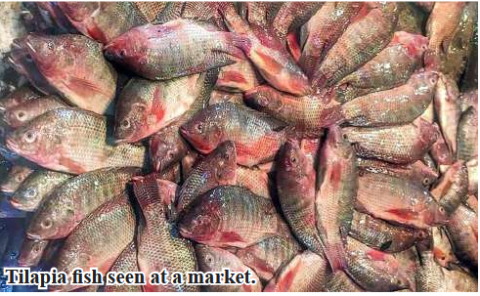
Nyaungdon June 17
Local merchants from Nyaungdon Township of Ayeyawady Region sold 70,000 viss of tilapia to Yangon market in May 2025, said Daw
Khin Khin Htay, the owner of marine product trading in Nyaungdon Township.
In April of this year, up to 50,000 viss of tilapia fish from Nyaungdon Township were successfully delivered and sold to the Yangon market. In May, up to 70,000 viss were delivered and sold.
Nyaungdon June 17
Local merchants from Nyaungdon Township of Ayeyawady Region sold 70,000 viss of tilapia to Yangon market in May 2025, said Daw
Khin Khin Htay, the owner of marine product trading in Nyaungdon Township.
In April of this year, up to 50,000 viss of tilapia fish from Nyaungdon Township were successfully delivered and sold to the Yangon market. In May, up to 70,000 viss were delivered and sold.
It is reported that in this region, fishery trade businesses purchase locally sourced fishery products, clean them systematically, and continue to export and sell them to the Yangon market.
"From our side, we mainly supply fishery products to the Yangon market. Since there is strong demand for tilapia fish in the local Yangon market, we were able to sell large volumes in viss weight. With such high volumes being delivered and sold, both producers and traders are doing well. Due to the increasing demand for fish, fish farmers are also increasing their stock," said Daw Khin Khin Htay.
Tilapia fish from Nyaungdon Township include both farm-raised and naturally caught varieties. The farming period for tilapia fish is about two and a half to three months. It is reported that tilapia fish delivered from Wakema Township to the Yangon market are currently being sold at prices as high as 14,500 kyats per viss.
Kyaw Kyaw Lin
Source: Yadanar Bon Newspaper
Nyaungdon June 17
Local merchants from Nyaungdon Township of Ayeyawady Region sold 70,000 viss of tilapia to Yangon market in May 2025, said Daw
Khin Khin Htay, the owner of marine product trading in Nyaungdon Township.
In April of this year, up to 50,000 viss of tilapia fish from Nyaungdon Township were successfully delivered and sold to the Yangon market. In May, up to 70,000 viss were delivered and sold.
It is reported that in this region, fishery trade businesses purchase locally sourced fishery products, clean them systematically, and continue to export and sell them to the Yangon market.
"From our side, we mainly supply fishery products to the Yangon market. Since there is strong demand for tilapia fish in the local Yangon market, we were able to sell large volumes in viss weight. With such high volumes being delivered and sold, both producers and traders are doing well. Due to the increasing demand for fish, fish farmers are also increasing their stock," said Daw Khin Khin Htay.
Tilapia fish from Nyaungdon Township include both farm-raised and naturally caught varieties. The farming period for tilapia fish is about two and a half to three months. It is reported that tilapia fish delivered from Wakema Township to the Yangon market are currently being sold at prices as high as 14,500 kyats per viss.
Kyaw Kyaw Lin
Source: Yadanar Bon Newspaper

